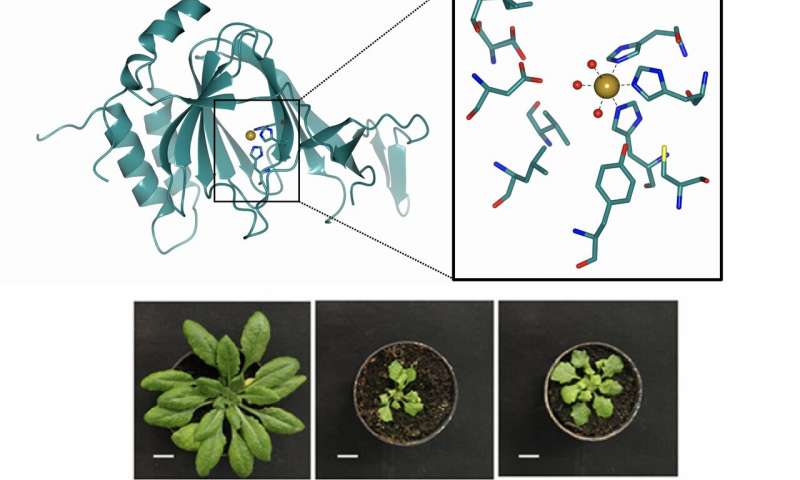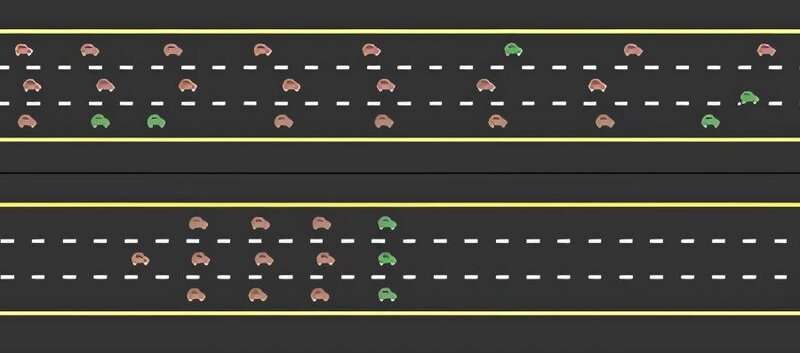
Crystal structure of PCO4, with comparison of ‘wild type’ (WT) plant and affected plant.
Tweaking proteins in staple foods could help feed a warming world
Enzymes that control a plant’s response to lower oxygen levels could be manipulated to make vital crops resistant to the impacts of flooding triggered by climate change, new research shows.
Co-author Dr Mark White in the School of Chemistry at the University of Sydney said: “Climate change is a major global issue, not least for its impact on food security. We hope these findings can help produce flood-tolerant crops to help mitigate the devasting social and economic impact of extreme weather events on food production.”
The research, largely done at the University of Oxford, is published today in the Proceedings of the National Academy of Sciences of the United States of America.
Climate change has increased the number and intensity of global flooding events, threatening food security through significant crop loss. Plants, including staple crops such as rice, wheat and barley, can survive temporary periods of flooding by activating energy pathways that don’t rely on air in response to the low oxygen conditions in water.
These responses are controlled by oxygen-sensing enzymes called the Plant Cysteine Oxidases (PCOs), which use oxygen to regulate the stability of proteins that control gene activity.
The research describes the molecular structures of the PCOs for the first time, identifying chemical features that are required for enzyme activity.
“The results provide a platform for future efforts to manipulate the enzyme function in an attempt to create flood-resistant crops that can mitigate the impact of extreme weather events,” Dr White said.
The Latest Updates from Bing News & Google News
Go deeper with Bing News on:
Crop resistance to flooding
- Corn crop conditions improve as acres and prices decline
Corn prices down, acres in Texas and across U.S. are expected to follow as improved overall conditions could deliver above average yields.
- Climate-Smart Agriculture: Adaptive Practices for Changing Weather Patterns
In the face of these challenges, adopting climate-smart agriculture (CSA) practices is crucial to ensure food security, mitigate greenhouse ...
- How climate change is impacting Pioneer Valley farmers
Every dairy farmer in the world knows that a comfortable dairy cow is going to give you more and better quality milk," said Denise Barstow Manz, of Barstow’s Longview Farm in Hadley.
- Drought preparedness through soil and crop management
As spring approaches, the agricultural community is becoming increasingly concerned about potential forecasts of drought across the southern Prairies. And ...
- Nigeria Floods to Further Cut Cocoa Crop, Adding to Shortage
Nigeria’s cocoa planting and mid-crop harvest will be disrupted as the Hydrological Service Agency has warned of heavy flooding in the country’s main cocoa growing areas. The flood prone ...
Go deeper with Google Headlines on:
Crop resistance to flooding
[google_news title=”” keyword=”crop resistance to flooding” num_posts=”5″ blurb_length=”0″ show_thumb=”left”]
Go deeper with Bing News on:
Plant Cysteine Oxidases
- How to plant and take care of azaleas
THERE’S A GUMBO THAT STAYS REAL SMALL AND THAT OTHERS GET HUGE AND THEN RHODODENDRON, SAME FAMILY OF PLANTS THAT YOU’RE GOING TO GET MUCH TALLER. OH, THAT’S WHAT I’M THINKING OF.
- The Best Places to Buy Plants Online
When the charming, local plant shop of your dreams refuses to materialize in reality, purchasing houseplants from an online plant purveyor can be the next best thing. We tested five of the most ...
- Connected Plant
Artificial intelligence (AI) is rapidly transforming the power sector, offering unprecedented opportunities for efficiency and innovation. But as AI applications proliferate, new challenges are ...
- Plant Design
New opposition has emerged surrounding a power plant Minnesota Power, Dairyland Power Cooperative, and Basin Electric Power Cooperative are teaming to build along the banks of the Nemadji River in… ...
- What does a plant need to grow?
Plants help people and animals to live. Plants provide food for people and animals to eat. They also make oxygen. All people and animals need oxygen to breathe. Plants can grow in many different ...
Go deeper with Google Headlines on:
Plant Cysteine Oxidases
[google_news title=”” keyword=”Plant Cysteine Oxidases” num_posts=”5″ blurb_length=”0″ show_thumb=”left”]










